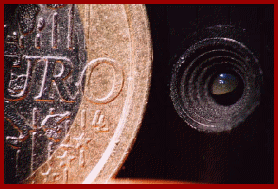| |||||||||||||||||||||||||||||
Welcome to the | |||||||||||||||||||||||||||||
 | |||||||||||||||||||||||||||||
 | |||||||||||||||||||||||||||||
Also the material that the camera looks through must be kept as thin as possible; at the sharp end of the lens, the thicker the material (e.g. a fibre board ceiling tile), the larger the hole required to produce an uninterrupted image. To help achieve accurate alignment using wide angle pinhole lenses, Doktor Jon has his own carefully constructed CCTV camera support frames, which use an M4 metric threaded rod (studding) and finger adjusted nuts, to achieve the degree of precision needed to raise and align the camera to the hole (particularly used in false ceilings). As an alternative (in some situations), a range of wooden blocks cut to differing angle wedges, can provide a reasonable base support. The camera is then gently ‘bedded’ onto artists modelling clay covered in a thin protective plastic layer ('cling film' is ideal). When the clay hardens over a period of a couple of days, the camera is then held firmly against any possible movement. It’s perhaps also worth mentioning that fibre optic bundles can also provide (pun not intended) a very flexible approach, but picture quality can be somewhat impaired, and the cost for many routine operations may well be prohibitive. In many situations, an alternative approach is to locate the camera well away from the target area, and use a conventional set-up, with the camera fitted with a powerful telephoto lens. For example, a 1/3” camera fitted with a 25mm lens and a x2 extender (i.e. equivalent to a 50mm f2 lens), will produce a full height image of a 6 feet (1.85 metre) tall person at approx. 72' (22m) from the camera ... looking through a 15mm hole!! | |||||||||||||||||||||||||||||
 | |||||||||||||||||||||||||||||
IMPORTANT: No material may be reproduced, copied or redistributed from this site, © doktorjon.co.uk 2004 - 2008 Homepage...:...Gateway...:...Technical Gateway....:....Quickfind Index....:....Equipment Directory | |||||||||||||||||||||||||||||

